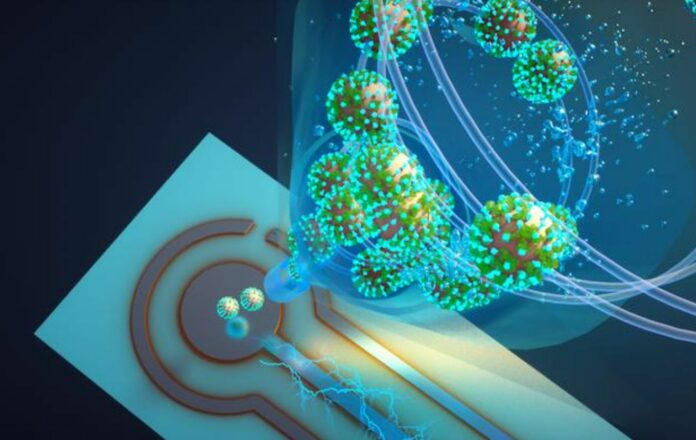“If you are in a room with 100 people, you don’t want to find out five days later whether you could be sick or not. There is nothing at the moment that tells us how safe a room is.”
But this new device developed by the McKelvey School of Engineering and the School of Medicine can detect any of the SARS-CoV-2 virus variants including flu, RSV, and other respiratory viruses in a room in about 5 minutes.
Scientists are now focusing on monitoring indoor environments in real-time for viruses following the end of the emergency phase of the COVID-19 pandemic. Researchers at Washington University in St. Louis have developed an inexpensive, proof-of-concept device that can detect any SARS-CoV-2 virus variants in a room within approximately 5 minutes. This device combines recent advancements in aerosol sampling technology with an ultrasensitive biosensing technique.
The monitor, which is considered the most sensitive detector available, has the potential to be utilized in hospitals, healthcare facilities, schools, and public spaces to detect CoV-2 and monitor other respiratory virus aerosols like influenza and respiratory syncytial virus (RSV). The findings of this research, conducted by an interdisciplinary team from the McKelvey School of Engineering and the School of Medicine, have been published in Nature Communications on July 10.
The team consists of Rajan Chakrabarty, the Harold D. Jolley Career Development Associate Professor of energy, environmental & chemical engineering; Joseph Puthussery, a postdoctoral research associate; John Cirrito, a neurology professor; and Carla Yuede, a psychiatry associate professor.
According to Cirrito, “There is nothing at the moment that tells us how safe a room is. If you are in a room with 100 people, you don’t want to find out five days later whether you could be sick or not.
“The idea with this device is that you can know essentially in real time, or every 5 minutes, if there is a live virus.”
Cirrito and Yuede previously developed a micro-immunoelectrode (MIE) biosensor that detects amyloid beta as a biomarker for Alzheimer’s disease. They explored the possibility of converting it into a detector for SARS-CoV-2 and reached out to Chakrabarty, who assembled the research team. Puthussery, with expertise in building real-time instruments for measuring air toxicity, joined the team as well.
To modify the biosensor for detecting coronavirus, the researchers replaced the antibody that recognizes amyloid beta with a nanobody from llamas that recognizes the spike protein from the SARS-CoV-2 virus. The nanobody, developed by David Brody, MD, PhD, from the National Institutes of Health (NIH), is small, easily reproducible, modifiable, and cost-effective.
Yuede explained that “The nanobody-based electrochemical approach is faster at detecting the virus because it doesn’t need a reagent or a lot of processing steps.
“SARS-CoV-2 binds to the nanobodies on the surface, and we can induce oxidation of tyrosines on the surface of the virus using a technique called square wave voltammetry to get a measurement of the amount of virus in the sample.”
Chakrabarty and Puthussery integrated the biosensor into an air sampler based on wet cyclone technology. The air enters the sampler at high velocities and combines centrifugally with the fluid lining the walls, creating a surface vortex that traps the virus aerosols. An automated pump collects the fluid and sends it to the biosensor for seamless virus detection using electrochemistry.
The wet cyclone sampler’s high virus recovery is attributed to its extremely high flow rate, which allows it to sample a larger volume of air over a 5-minute collection period compared to commercially available samplers. While most commercial bioaerosol samplers operate at low flow rates, the team’s monitor has a flow rate of approximately 1,000 liters per minute. It is also compact, measuring around 1 foot wide and 10 inches tall, and illuminates when a virus is detected, alerting administrators to increase airflow or circulation in the room.
The researchers conducted tests in the apartments of two COVID-positive patients. Air samples from the bedrooms were compared with air samples from a virus-free control room using real-time PCR. The devices detected RNA of the virus in the bedroom air samples but did not detect any in the control samples.
In laboratory experiments involving aerosolized SARS-CoV-2 in a chamber of room size, the wet cyclone and biosensor successfully detected varying levels of airborne virus concentrations within a few minutes of sampling.
Cirrito emphasized that while they initially focused on SARS-CoV-2, there are plans to measure other pathogens such as influenza, RSV, rhinovirus, and other commonly occurring pathogens. In a hospital setting, the monitor could be used to detect staph or strep, which can cause various complications for patients. This device has the potential to make a significant impact on people’s health.
Source: 10.1038/s41467-023-39419-z
Image Credit: Joseph Puthussery
